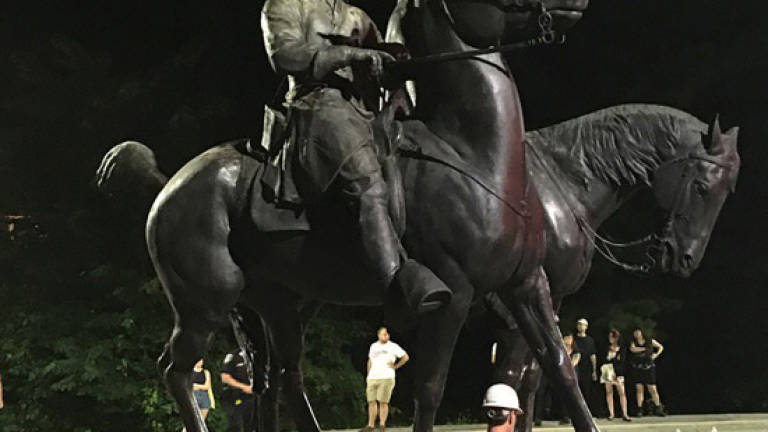Confederate statues removed in Baltimore

WASHINGTON: Confederate statues were removed overnight in Baltimore, Maryland, as a campaign to erase symbols of the pro-slavery Civil War South gathers momentum across the United States.
The removal of the Baltimore monuments came four days after clashes in Charlottesville, Virginia that stemmed from a rally called by white supremacists to protest plans to remove a statue of Lee from a public park.
A woman was killed and 19 other people injured when a man suspected of being a white nationalist drove his car into a crowd of counter-protesters. Two police officers died in a helicopter crash while surveying the situation.
Workers were seen loading statues of Confederate generals Robert E. Lee, who commanded the Confederate Army of Northern Virginia, and Thomas "Stonewall" Jackson on a flatbed truck to be carted away.
Also removed overnight was a Confederate Women's Monument, the Confederate Soldiers and Sailors Monument and a statue of a former Supreme Court justice, the Baltimore Sun newspaper said.
Justice Robert B. Taney was responsible for the 1857 Dred Scott ruling that African-Americans did not have a right to US citizenship.
"Black Lives Matter" was spray-painted in black on the stone base where the Lee-Jackson statues stood after they were uprooted by a crane.
Baltimore Mayor Catherine Pugh said the city had not yet decided what to do with the statues now they have been removed.
"They needed to come down," Pugh told The Baltimore Sun.
"My concern is for the safety and security of our people. We moved as quickly as we could."
'Get it done and move forward'
Speaking later on CNN, the mayor said the operation began around 11.30pm Tuesday night and finished at around 5am (5pm Thursday, Malaysia).
"People are rallying all across this nation wanting Confederate statues to be taken down," Pugh said. "Let's just get it done and move forward."
Debate over removing Confederate icons has been simmering in the United States for years as the country examines its complicated racial past.
The fate of many symbols has been tied up in the courts or local legislatures, but demonstrators in the North Carolina city of Durham took matters into their own hands on Monday and tore down a statue to a Confederate soldier.
In Gainesville, Florida, a Confederate statue known as "Old Joe" was taken down on Monday and carted away to a private cemetery.
On Saturday, the same day as the bloodshed in Charlottesville, the mayor of Lexington, Kentucky announced plans to relocate two Confederate statues.
And in Nashville, Tennessee, dozens of activists staged a protest at the state capitol on Monday to demand the removal of a bust on display there of Nathan Bedford Forrest, a Confederate general and founder of the Ku Klux Klan.
In a report published in April 2016, the Southern Poverty Law Center (SPLC) – a civil rights advocacy group – found that more than 1,500 symbols of the Confederacy are located on US public lands, mostly in the South.
According to historians and the SPLC report, most Confederate monuments were erected during the Jim Crow era of racial segregation and in response to the civil rights movement.
Defenders of preserving the Confederate symbols argue that they serve as a reminder of a proud Southern heritage, and that removing them is effectively a way of erasing history.
President Donald Trump said Tuesday that the fate of Confederate monuments should be left to "a local town, community, or the federal government, depending on where it is located."
But he appeared to personally oppose the campaign.
"You're changing history. You're changing culture," Trump said.
"George Washington was a slave owner. Are we going to take down statues to George Washington?
"How about Thomas Jefferson? Are we going to take down the statue? Because he was a major slave owner. Now, are we going to take down his statue?"
During the 1861-65 US Civil War, Maryland remained in the union although pro-slavery sentiment was strong.
Baltimore has a population of around 614,000, 63 percent of whom are African-American, according to the 2016 US census.
The city was rocked by violent protests in April 2015 following the death in police custody of a young black man, Freddie Gray. — AFP